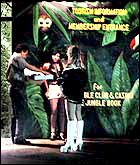
Every evening at 6 p.m. she walks out into the streets of San Jose, Costa Rica’s capital, wearing an impossibly short miniskirt, high heels, and a tight shirt. She offers oral sex for $15 and what she calls “complete sex” for $50.
Meet Liliana, 11 years old, and already part of Costa Rica’s fast-growing work force: child prostitutes.
Marketing itself as the Mecca of ecotravel and a bastion of tranquility amidst its more unstable Central American neighbors, Costa Rica has managed to make tourism its major source of revenue. Last year alone it attracted one million visitors — double the number of just a decade ago.
With thousands of these vacationers estimated to be “sex tourists” seeking underage partners, it’s not surprising that young Costa Rican boys and girls who sell their bodies are as much of a tourist attraction as the pristine beaches and lush jungles.
The boom in child sex is being fed, in part, by the massive Internet promotion of Costa Rica as a destination for sex tourism.
“Sexual tourists look for destinations that can offer them impunity and anonymity, and for poverty levels that will push children to engage in prostitution,” says Bruce Harris, regional director of Casa Alianza, the Latin American branch of international child care agency Covenant House.
Costa Rica is by no means the only Central American country with child prostitution. Children can be found selling sex to escape extreme poverty and unhappy homes all through the isthmus, but in Costa Rica the problem seems to be out of control.
“Costa Rica is the undisputed leader in the region, with Honduras a distant second,” says Harris. “However, the reaction of the authorities in both countries is substantially different. The minister of tourism in Costa Rica considers us to be the enemy because we give out a bad image of the country. His Honduran counterpart got together with us as soon as concerns over child prostitution were raised to devise a common strategy to fight the problem.”
Though highly visible in major coastal towns and other tourist destinations, the exact number of child prostitutes is unknown. The government of Costa Rica has not bothered to gather detailed statistics, says Rocio Rodriguez Garcia, coordinator of the defense and investigation division at Casa Alianza.
According to Rodriguez, NGOs and other agencies have estimated as many as 3,000, but some in the Costa Rican leadership continue to play down the problem. The nation’s minister of security said on national television that those estimates were inaccurate and that there are only 15 girl prostitutes in Costa Rica. Rodriguez says her own experience contradicts the claim: She fields an average of five complaints a week.
Outside organizations are stepping up the pressure on Costa Rica’s authorities. Last year, the UN Committee on Human Rights reported that it was “deeply concerned” over the rise in child sexual tourism in Costa Rica and urged the government to take steps to wipe it out. Last March, Casa Alianza presented a formal complaint to the Inter American Commission on Human Rights, despite efforts by Costa Rican diplomats to thwart the hearing.
“The government has made great efforts to address this problem,” insists Jaime Daremblum, Costa Rica’s ambassador to Washington DC. Last year, the government passed toughly worded legislation aimed at reducing child prostitution, he points out. Under the new legislation, adult clients of children who are sexually exploited can be prosecuted for sexual abuse, and the production and distribution of child pornography are now criminal offenses.
“Tourists are warned about the consequences of these types of activities” before they enter the country, according to Daremblum.
Given that just over a year ago, people who had sex with children could avoid prosecution by agreeing to marry the victim, the new legislation is a positive change. But international pressure and stricter laws only go so far.
“We have tons of international treaties and laws in place, but we lack implementation,” says Rodriguez. “Lack of appropriate infrastructure, coupled with widespread corruption makes law enforcement very difficult.”
The government’s sex-crimes division has only seven agents and even fewer vehicles to cover the whole country. And corruption among agents makes enforcement a sickening irony: According to the document presented to the IACHR by Casa Alianza, many young girls are forced to give oral sex in police cars to the agents who detain them. The report also describes how, during a raid on a building where foreigners sexually exploited children, a high-ranking police official helped the American owner of the business escape over the back wall.
“Even when offenders are prosecuted, there are no rehabilitation programs for the girls, and they go right back to the streets,” says Tapiana Tregar, executive director of Fundacion Procal, a local NGO that works to prevent and treat violence against women and children.
According to Fundacion Procal’s studies, 83 percent of the girl prostitutes interviewed had been abused at home. The study concluded that the resulting low self-esteem combined with poverty drove the girls to prostitution. “In their minds, the abuse and violence that they suffer in the streets is a continuation of the abuse and violence they experienced at home,” explains Tregar. “Only that in the streets they are making money out of it.”
Tregar argues that blaming the high numbers of child prostitutes on the influx of tourists is to look away from the real root of the problem. “Child prostitution existed before the tourism boom. Even now the main source of clients is local,” she says. “We Costa Ricans just have a hard time accepting the fact that this phenomenon is more about ourselves than about outsiders.”












